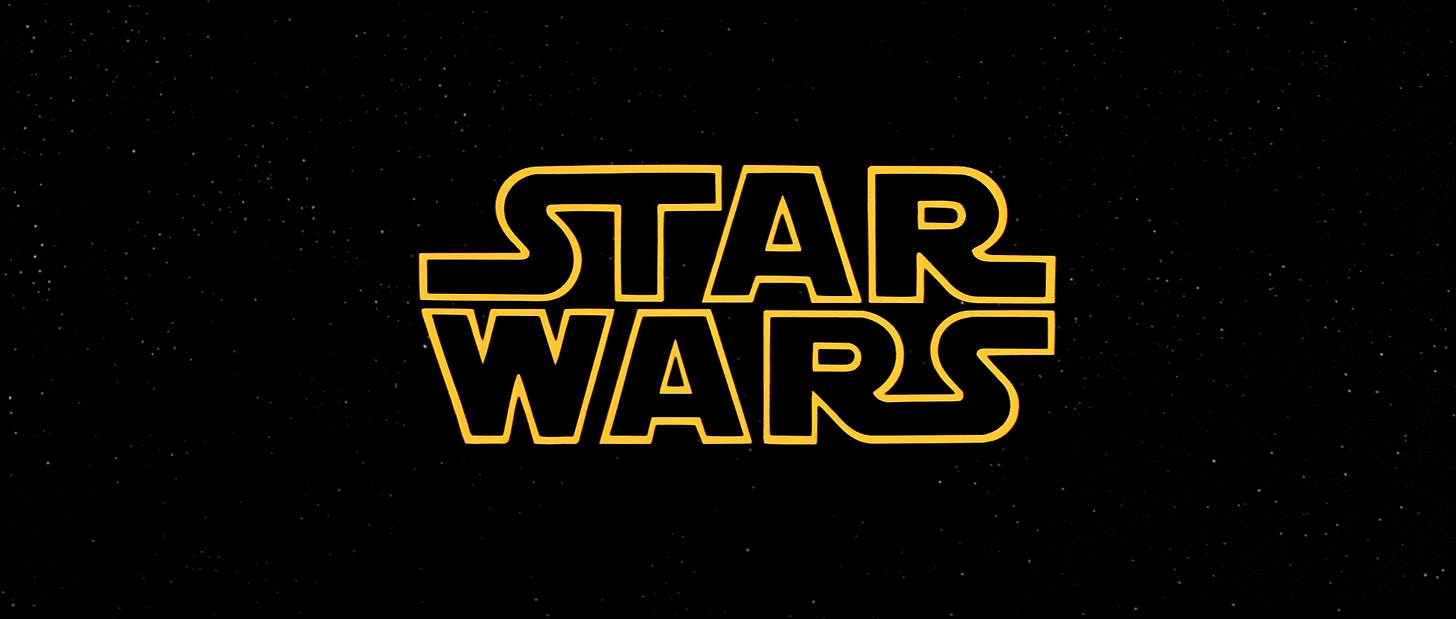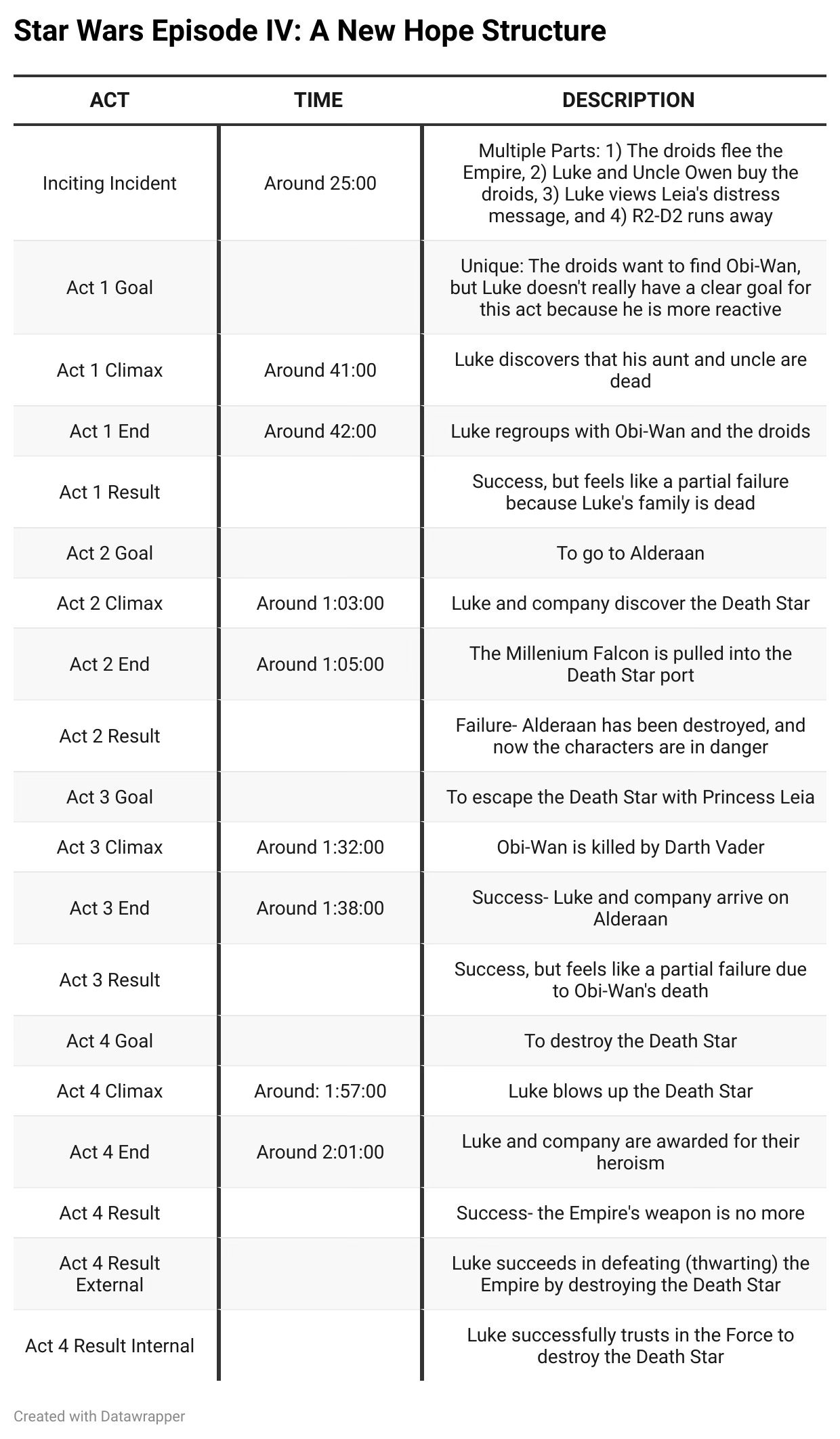Star Wars Episode IV: A New Hope
I’m incredibly excited to introduce a new set of contributors to The Hutch Files—my students in the Storytelling 4 class in the MFA Program at the University of Central Arkansas. Over the next few weeks, I’ll be posting their structure breakdowns on some of their own favorite films. I think they’ve done an incredible job and bring some great insights to the films they’ve chosen. Please see their individual bylines at the top of each post. So here we go:
Greetings, reader! Welcome to my analysis of Star Wars: Episode IV – A New Hope by George Lucas. A New Hope, originally just titled Star Wars upon its release on May 25th, 1977, is the film that jumpstarted George Lucas’ career. While his earlier films, THX 1138 (1971) and American Graffiti (1973), have contributed to American cinema in their own right (anyone remember the THX intro that used to play before a movie?), A New Hope took Lucas to new heights, resulting in a billion-dollar movie franchise that has made him one of the wealthiest creators in Hollywood today. The film also “discovered” incredibly talented actors, including (but not limited to) Mark Hammil (as Luke Skywalker), Harrison Ford (as Han Solo), and Carrie Fisher (as Princess Leia). It also featured pre-established stars like Sir Alec Guiness (as Obi-Wan Kenobi).
As always, these breakdowns contain SPOILERS, and are only recommended if you've already seen the movie. You can check the introduction to these breakdowns, to get an overview of the process and philosophy.
The Basics
Director: George Lucas
Writer: George Lucas
Release Date: 1977
Runtime: 121 Minutes
IMDB: https://www.imdb.com/title/tt0076759/
Movie Level Goals
Protagonist: Luke Skywalker
External: Stop the Empire
SUCCESS | FAILURE | MIXED
Internal: Trust in the Force
SUCCESS | FAILURE | MIXED
Goal Relationship: Internal leads to External. He must trust in the Force so that it may guide him in his fight against the Empire, ultimately allowing him to accurately fire a shot that destroys the Death Star and puts a stop to the Empire’s plans– for the time being.
Three Observations
Observation #1: No Protagonist In the Opening of the Film
Beginning a film with a scrolling title sequence has become heavily associated with the Star Wars franchise because every film in its catalog utilizes this technique. It is rare, but not unusual, for sci-fi or fantasy epics to begin with some form of long exposition (walls of text or narration– take your pick). It is also not uncommon to begin these types of movies with some action; A New Hope is no different. We begin with an Imperial Star Destroyer pursuing Princess Leia’s ship. After their engines are destroyed, stormtroopers board the ship with Darth Vader–a menacing antagonist whose fame is rivaled by few in all of fiction–and the droids C3-PO (played by Anthony Daniels) and R2-D2 (played by Kenny Baker) are forced to flee in an escape pod after Princess Leia gives R2-D2 the Death Star plans. They crashland on the desert planet, Tatooine, and are eventually captured by a tribe of Jawas before being sold to Uncle Owen to work on his farm.
All of this (from the title sequence to the droids being sold) happens within the first twenty minutes of the movie. We have exposition, action, stakes, and a large cast of characters– but there’s one important thing missing. Where’s our protagonist? The first scene to feature Luke doesn’t happen until after the droids have been captured by Jawas; we don’t even see our protagonist until roughly fifteen minutes into the movie! George Lucas could have begun the film with Luke, but that would’ve been boring– we would have less of an idea of what this galaxy is like (who the good guys and bad guys are, what the Empire are looking for, why the droids are important, etc.). We start with the droids not only because the action happening in space is far more interesting than whatever is going on Luke’s farm, but because they are the vessel for Luke’s inciting incident–Princess Leia’s holotape. By choosing to start with the droids, Lucas allows us 1) to get an idea of the fictional universe of the story, 2) to be thrust into the story so that we are not too bored from the opening crawl, and 3) to provide a way for Luke, a nobody from nowhere, to receive a call to action in a fun and believable way.
Observation #2: Murky Inciting Incident, Murky Act Goal
My next observation is directly connected to the last. I had mentioned that the droids serve as “the vessel for Luke’s inciting incident”; while I believe this to be true, it is difficult to pinpoint what the inciting incident actually is. Note that Luke and Uncle Owen don’t even purchase the droids until around the 19-minute mark. Additionally, Luke doesn’t watch Leia’s holotape until the 25-minute mark. One could argue that the holotape discovery is the inciting incident of the film because it kickstarts Luke’s involvement with the droids’ mission (to deliver the Death Star plans to the Rebel Alliance). However, an inciting incident is supposed to be a change in the life of a character; their goal should become clear once this incident happens. But what is Luke’s goal after he watches Leia’s holotape? To find Obi-Wan? That seems like an act-level goal (and a shoddy one at that– we’ve spent the last twenty-five minutes following the droids around, and this seems more like their goal rather than his).
So, what’s going on here? As established previously, the movie begins in an odd way by following the droids and not Luke. The first act doesn’t end until Luke returns home to find his aunt and uncle dead–it is this moment that begins his movie-level goals (he has nothing on Tatooine now–he will go with Obi-Wan to learn the ways of the Force and stop the Empire). If anything, Luke himself does not have a clear act goal; it is the droids’ actions towards their goal of finding Obi-Wan that prompts Luke to react. Therefore, Act I seems to lack a clear goal.
Now, back to our inciting incident problem: with no clear act-level goal and Luke’s journey not really beginning until the end of Act I (he returns to Obi-Wan and asks to go with him to Alderaan), it is difficult to determine what the movie’s inciting incident is. Is it Princess Leia giving R2-D2 the Death Star plans (this moment gives the droids their goal of getting the plans to the Rebel Alliance)? Is it when the droids are purchased (this moment leads to deaths of Luke’s aunt and uncle because they became affiliated with the droids the moment the transaction happened)? What about when Luke watches the holotape, which sends him to Obi-Wan and inadvertently spares him from the fate of his family? Or is it when R2-D2 runs away, forcing Luke and C3-PO to go looking for him and accidentally running into Obi-Wan after they are ambushed by Tusken Raiders?
It’s a tough call, but I argue that Luke discovering the holotape is the inciting incident for three main reasons: 1) it leads him to Obi-Wan, who’s mission to help Leia becomes Luke’s quest as well, 2) it saves his life, allowing for the movie to continue while also allowing for there to be an act climax that drives Luke to take action (the death of his family is a powerful motivator), and 3) it happens more than halfway into the act (Act I ends around the 42-minute mark; in a traditional 30-minute first act, the inciting incident often happens around the 17-minute mark, or slightly more than the halfway point–at least according to famous screenwriting guru Syd Field). In short, Act I of A New Hope is a bit messy, but with some effort, we can still get an idea of what the inciting incident is, even if the goal belongs more to the droids than to Luke.
Observation #3: An Unfinished Narrative
A final observation that I’d like to make is (thankfully) not related to the beginning of the film, but the ending. Luke destroys the Death Star and saves the galaxy from the Empire’s world-killing weapon. The day is won, yes–but next? Note how in my movie level goal breakdown I listed Luke’s external goal as “stop the Empire” and not “defeat the Empire”. With the Death Star destroyed, Luke and the Rebel Alliance have cost the Empire dearly, but they didn’t actually defeat the Empire because the Empire still exists, complete with a functional military and government. As a result, the movie ends on a celebratory note that, while earned–the Death Star was not a light threat to the many planets or their populaces–leaves us wondering what comes next. More specifically, one may ponder what plans the Rebel Alliance has or more importantly, what the Empire may do in retaliation.
For better or for worse, A New Hope is one of those films that made the concept of sequels a popular occurrence. After A New Hope’s massive success, audiences were craving more–this was, at least in part, by design; George Lucas had plans for a space epic, and though there is much evidence to suggest that he may not have had a concrete plan ready, this film was meant to be the start of something greater. A New Hope is one complete arch in the great story of Star Wars–a defining moment for its characters and the world in which they exist–but it ends with more left to say, and the audience is Forced (see what I did there?) to anticipate the next installment.
Were A New Hope a one-off deal, the movie would have had to end differently– perhaps too quickly. We may have seen Luke somehow kill Vader before becoming a proper Jedi–maybe he would have been on the Death Star, but that would have been boring–and the Empire would need to surrender after their defeat. But therein lies the problem with epic stories: depending on how big the scale, it is very difficult to compress it into the runtime of a single film. If Luke had defeated Vader and the Empire surrendered, the audience would not have bought the ending; there’s no believable way that Luke could become powerful enough to defeat both Vader and the Empire without proper training or (feel free to groan) some sort of ex-machina event. Thus, regardless of George Lucas’ smart marketing ideas, Star Wars needed sequels to tell a good story–one that doesn’t feel too rushed and has time to develop its characters and its world. To summarize my point: Star Wars is partially (or largely) responsible for modern Hollywood’s “sequel-itis” (and with the next installment, Episode V: The Empire Strikes Back, “cliffhanger-ending-itis”), but it needed sequels in order to flush out the story that was only beginning in A New Hope.













